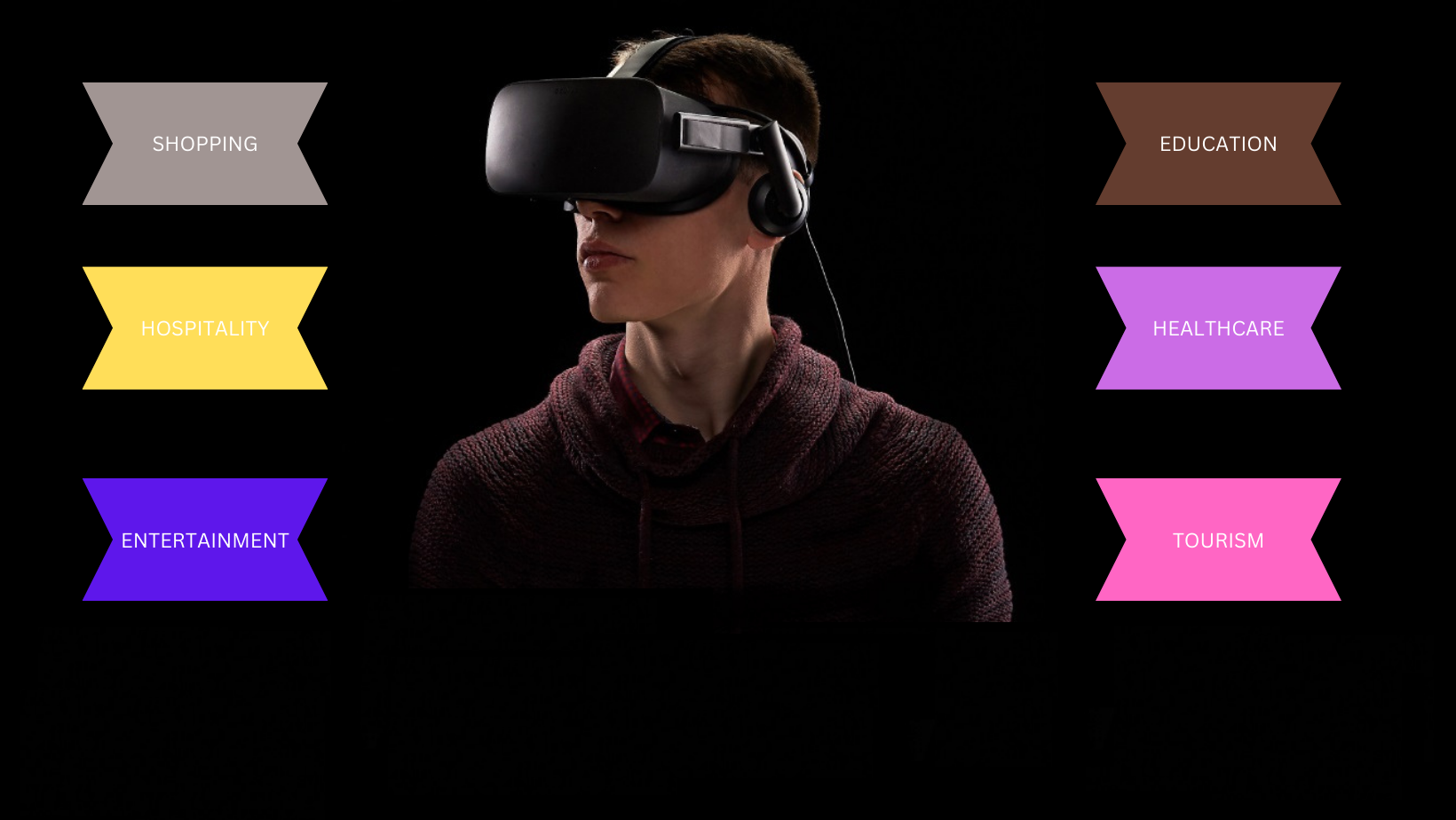Although virtual reality technologies started getting exploited in gaming, they are now used across niches and applications. There are many applications of VR in today’s world, including in education, tourism & hospitality, entertainment, and healthcare.

If you’re unsure what VR tech means, VR – Virtual Reality – is a term for computer-generated environments overlayed on actual surfaces for users to interact between the real world and the virtual (computer-generated) world.
Similar to VR is AR (Augmented Reality), which has also evolved into many applications, including retail shopping. Augmented Reality and Virtual Reality make it possible for people to interact with virtual and physical worlds as though they are one.
12 Uses of VR Other than Gaming
Virtual reality applications keep expanding beyond the gaming horizon and these are some of the top niches that have adopted VR techs in diverse ways.
1. Healthcare
Virtual reality technologies are deployed in the healthcare niche – used in training medics (mostly surgeons) on how to perform different medical assignments. Even so, in November 2021, the FDA approved prescription-use EaseVRx for treating pain reduction in adults.
VR also helps out in tele-surgery and other applications. More and more VR-powered systems are being launched to assist professionals in the healthcare niche. Today, many clinics offer CR therapy – a proven therapy for treating PTSD and anxiety.
2. Education
With no doubt, VR has helped educators simplify most of their tasks. Using VR solutions, educators and teachers can simulate historical events or science experiments to clearly explain a topic to their students. Also, students can have virtual field trips while inside the classroom and still get to interact with objects in the field as though they are physically touching them.
Through virtual reality solutions, modern education is now more immersive and engaging than ever. Students with disabilities can use VR solutions to learn without limits. However educative VR solutions are very expensive to set up, which is why the technology hasn’t been widespread in the niche.
3. Tourism
Here is another niche where virtual reality technologies are heavily invested in. Through virtual reality solutions, tourism companies can give their clients and hopefuls a feeling of how their intended trip could be and a view of everything they will have access to see or touch. This way, tourists can explore a destination even before they visit the place.
4. Hospitality
In the hospitality niche, VR technologies come in handy in many ways. Hotels now provide their customers with customized VR-powered apps, which allow the customers to have a 360-degree view of their suites and apartments before they make reservations. Other hospitality service providers can also leverage VR solutions to upscale their services.
5. Entertainment
Virtual reality is applied in the entertainment niche. Some modern VR headsets support movie streaming, which means you can watch the latest episodes from your headset unit. Platforms like Disney Movies VR and YouTube support VR 360 videos. Other movie streaming services are rapidly adopting the tech.
Entertainment companies like Flipside Studio allow creators to create interactive content that are accessible using VR devices. Flipside includes support for Meta Quest devices and the Rift Store. More so, artists can host virtual concerts where fans can connect using their virtual headsets – platforms like Twitch support this feature.
6. Museums and Art Galleries
Quite a number of art centers and museums now have VR-powered apps that allow tourists to interact with the artifacts and items inside the museum. Through VR technology, museums can create interactive, realistic simulations of historical events, persons, cultures, or environments to keep their visitors entertained.
Art galleries also make use of VR technologies to make exhibitions more interactive and “immersive.” Participants can see all aspects of an exhibition with explicit details while enjoying unique “personal” experiences.
7. Automotive Manufacturing
By utilizing VR technology, automotive engineers and designers can easily experiment with prototypes to see exactly how the car will look and perform after it is built. Top automotive companies like Jaguar, Honda, Land Rover, and BMW all use VR to hold design and engineering reviews.
So basically, virtual reality in the automotive industry is for testing new designs and prototypes through various scenarios and conditions. A report shows that in Ford’s Immersion Lab in Dearborn, Michigan employees wear VR headsets to examine every part of a car before it is manufactured.
8. Retail Shopping
Many top retail stores are now infusing virtual reality and augmented reality techs to help improve their customers’ experience. Using VR technologies, customers can try out gear and clothes and see how those items will fit them when they actually wear them. Also, AR techs help retail stores guide customers on where to find the items they are looking to shop.
Fashion stores, supermarkets, and other retail stores can all benefit from VR technologies, and thankfully, a good number of them have already started adopting the innovative tech. Today, you will find VR rooms in some top brands’ shopping centers where customers can access and have an immersive shopping experience.
9. Interior Design and Home Remodeling
3D was the game before now, but most home remodeling softwares and interior designers now infuse VR to let homeowners see exactly how their house would look after a revamp. Also, there are VR apps that allow homeowners to remodel their homes and place any new thing they wish to add.
10. Real Estate
Yes, virtual reality is also used in real estate; it is used to show clients every nook and cranny of a property they are trying to purchase. These VR techs in real estate make clients feel like they are already inside the property and they can view every aspect of the structure, as well as ask real-time questions about any part of the building they need clarification on.
With the help of VR, clients need not travel long distances to physically inspect properties they want to purchase – they can stay in the comfort of their homes and enjoy a wholesome view of their prospective property. Talk about saving the cost of transportation and overheads? Yes, that’s another benefit of VR in real estate.
11. Space
World popular space company, NASA, has countlessly used Oculus Rift VR and other VR headsets to share the experience of being on board different space vessels. This is usually during annual CES events.
Virtual reality technology is widely adopted by space companies around the world to offer their event attendees – and employees who are not in the team that visits space – the feeling of being in space. Also, space VR games have been developed for VR device owners to play and have the immersive experience of being in space.
12. Engineering and Robotics
Before now, in the 1990s, 3D computer-aided design (CAD) was the real deal, but thanks to tech evolutions, 3D tracking and computer technology have enabled its use in VR environments. Virtual reality aids prototyping, assembly, service, and performance use cases. So, engineers across disciplines can feel and experience their designs – view their designs from all angles.
Also, simulations allow engineers to test their structure’s resistance to different elements such as winds and weight. Virtual reality can control robots in telepresence, teleoperation, and telerobotic systems. There are many use cases of VR in engineering and robotics – many OEMs have adopted this technology for a long time now.
What More?
These are the top 12 applications of virtual reality aside from gaming. Yes, VR is not only useful in the gaming niche, it has become more versatile and handy across niches. Apparently, these are not the only applications of VR, but these are the top ones to know.
